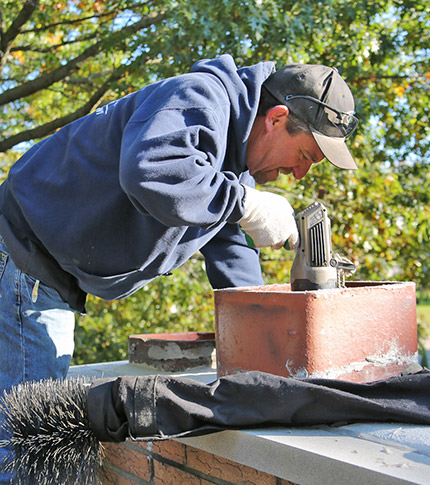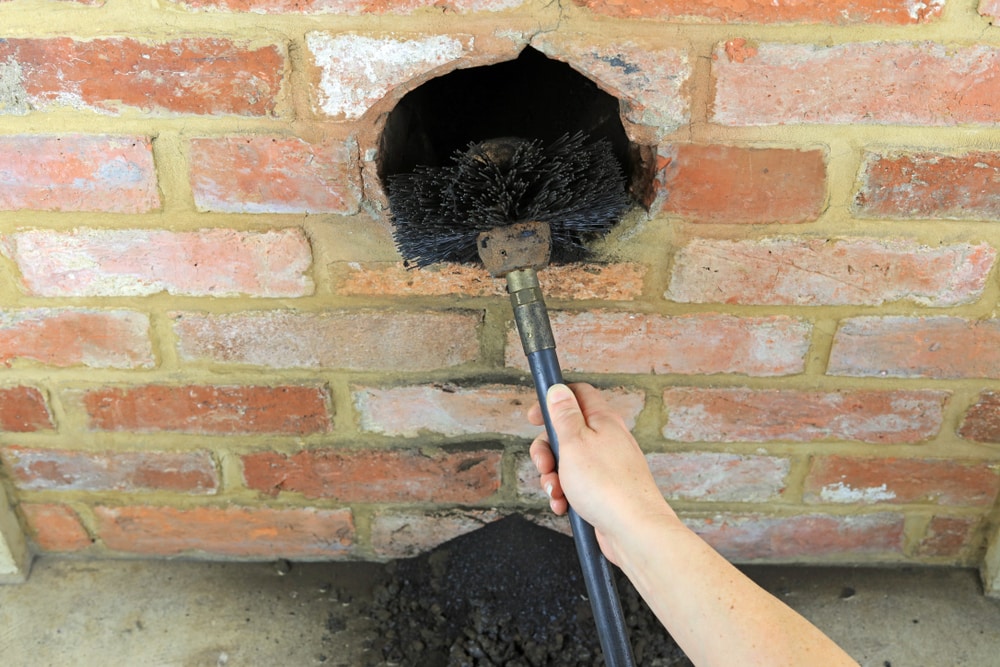Premier Chimney Clean Company Fremont: Trust Fund United States for a Clean Fire place
Premier Chimney Clean Company Fremont: Trust Fund United States for a Clean Fire place
Blog Article
Why Normal Chimney Cleansing Is Crucial for Home Security
Normal chimney cleaning is an usually forgotten yet crucial aspect of preserving a secure and protected home environment. While it might not be one of the most interesting or glamorous task on your order of business, overlooking smokeshaft maintenance can have major repercussions. The buildup of soot and creosote in your chimney can position a considerable fire danger, while poor ventilation can cause the potentially dangerous risks of carbon monoxide poisoning. Additionally, routine chimney cleansing can help extend the lifespan of your smokeshaft, saving you from pricey fixings or substitutes down the line. But how exactly does chimney cleansing add to home security? Allow's check out the reasons behind this crucial upkeep task and discover the tips for proper smokeshaft care that every property owner must understand.
Importance of Regular Smokeshaft Cleaning
Regular smokeshaft cleansing is crucial for preserving a effective and secure home setting. Over time, creosote, an extremely combustible material, builds up inside the chimney.
Along with preventing fires, routine chimney cleaning additionally ensures the efficient operation of your furnace. When creosote collects, it limits the air movement via the smokeshaft, resulting in inadequate burning and decreased heating efficiency. This can result in higher energy expenses as your furnace functions harder to preserve the preferred temperature level. By consistently cleaning up the smokeshaft, you can maximize the air movement and take full advantage of the effectiveness of your furnace.
Moreover, a tidy smokeshaft promotes excellent indoor air high quality. As the chimney ends up being clogged with creosote and debris, it can prevent the appropriate ventilation of damaging gases, such as carbon monoxide.
Fire Hazard: Build-up of Residue and Creosote
The accumulation of residue and creosote inside the chimney postures a considerable fire hazard, as it can ignite and create a potentially devastating chimney fire. Soot is a black, carbonaceous substance that is developed when timber or fossil fuels are melted. It contains great fragments that can quickly come to be airborne and work out inside the smokeshaft. Gradually, these fragments develop a layer and gather of soot. Creosote, on the various other hand, is a very combustible and sticky substance that is created when timber or nonrenewable fuel sources are shed at reduced temperature levels. It is a byproduct of incomplete burning and can stick to the inner walls of the smokeshaft.
The extreme heat generated throughout a chimney fire can cause the chimney to split or collapse, leading to a prospective house fire. In addition, the fires and triggers from the smokeshaft fire can escape via the chimney cap and ignite the roofing system or surrounding flammable products.

Routine chimney cleansing is necessary to remove the buildup of residue and creosote and minimize the threat of a smokeshaft fire. An expert chimney move will use customized brushes and devices to thoroughly cleanse the chimney, removing any kind of collected debris. By keeping the chimney free and tidy from soot and creosote, homeowners can make certain the risk-free and reliable operation of their fireplace or range, while additionally protecting their home from the dangers of a smokeshaft fire.
Poor Ventilation and Carbon Monoxide Gas Risks
Inadequate ventilation in smokeshafts can position significant dangers of carbon monoxide poisoning. Carbon monoxide gas (CO) is an anemic, odorless gas that is generated when fuels such as oil, gas, or timber are burned. When chimneys are not appropriately ventilated, carbon monoxide can construct up and seep into the home of a home, resulting in possibly life-threatening scenarios.
Among the primary sources of poor smokeshaft ventilation is the accumulation of debris, such as residue and creosote, which can block the flue and limit the circulation of air. This can result in incomplete combustion and the manufacturing of greater levels of CO. Additionally, a chimney that is not consistently cleaned can have an accumulation of various other obstructions, like bird nests or leaves, more impeding the appropriate ventilation of unsafe gases.
The impacts of carbon monoxide poisoning can be subtle and conveniently misinterpreted for various other illnesses, such as the influenza. Signs and symptoms may consist of headaches, wooziness, nausea, complication, and tiredness. Prolonged direct exposure to high levels of CO can lead to unfamiliarity, organ damage, and even fatality.
Normal chimney cleaning and evaluation are vital in preserving proper ventilation and decreasing the risk of carbon monoxide poisoning. By eliminating any type of obstructions and guaranteeing that the flue is clear, property owners can enjoy a view it now secure and healthy and balanced living environment. It is suggested to have chimneys evaluated and cleansed a minimum of yearly by a specialist chimney sweeper to ensure optimal safety and satisfaction.
Extending the Life-span of Your Chimney
To ensure the durability of your chimney, correct maintenance and treatment are necessary. Regular chimney cleansing is not only important for home security but additionally for extending the lifespan of your smokeshaft. Over time, creosote, soot, and particles can accumulate inside the smokeshaft, resulting in numerous issues that can substantially minimize its lifespan.
One of the major benefits of regular smokeshaft cleaning is the prevention of smokeshaft fires. Creosote, a black, tar-like substance created by the insufficient combustion of wood, is very flammable. Otherwise removed, it can accumulate inside the chimney and ignite, triggering a dangerous and potentially disastrous chimney fire. By consistently cleansing the chimney, you can eliminate this build-up and minimize the danger of a fire.
Additionally, routine chimney cleaning additionally aids to prevent blockages. When particles, such as fallen leaves, branches, or also tiny pets' nests, block the smokeshaft, it can impede appropriate air flow and air flow.
Along with avoiding fires and blockages, regular smokeshaft cleansing can likewise identify and address any potential damages or deterioration. By examining the chimney throughout the cleaning procedure, you can capture any kind of early signs of splits, leakages, or architectural problems. Motivate repair services can be made to avoid more damages and extend the life-span of your chimney.
Tips for Proper Smokeshaft Maintenance
For effective smokeshaft maintenance, it is essential to adhere to a few vital ideas to make sure the durability and safety and security of your chimney. These tips will certainly not only aid you preserve the performance of your chimney but likewise lower the threat of chimney fires and other possible risks.
To start with, it is important to have your chimney inspected and cleaned up by a specialist chimney move at the very least annually. A professional will certainly have the ability to determine any prospective concerns such as creosote buildup, animal nests, or structural damage that might posture a threat to your smokeshaft's performance and security.
Along with yearly examinations, it is very important to frequently examine and cleanse your smokeshaft's flue and cap. The flue needs to be clear of any type of particles or blockages that could limit air movement or create smoke to back up into your home. The chimney cap need to remain in good condition, securely connected, and without any kind of cracks or damage to prevent unwanted guests such as birds or squirrels from entering your smokeshaft.
Moreover, it is vital to use seasoned and completely dry wood for shedding in your fireplace. Wet or green wood generates even more smoke and creosote, causing a greater danger of smokeshaft fires. Furthermore, stay clear of burning materials such as garbage, cardboard, or dealt with timber, as they can launch dangerous chemicals and damage your smokeshaft.
Lastly, ensure that your smokeshaft is outfitted with a sturdy spark arrestor to avoid stimulates and embers from getting away and potentially causing a fire. Chimney Clean Company Fremont.
Complying with these suggestions for appropriate helpful site chimney maintenance will assist guarantee the security and long life of your chimney and offer satisfaction for you and your family members.

Conclusion
In conclusion, regular chimney cleansing is essential for keeping home safety and security. The build-up of residue and creosote can bring about fire hazards, while inadequate ventilation can boost the threat of carbon monoxide gas poisoning. By regularly cleansing and preserving your smokeshaft, you can extend its life-span and ensure the security of your home and family. It is essential to adhere to appropriate chimney upkeep pointers to protect against any kind of possible dangers.

One of the main benefits of normal smokeshaft cleaning is the prevention of chimney fires - Chimney Clean Company Fremont. The chimney cap should be in excellent problem, securely attached, and free of any kind of splits or damage to protect against unwanted visitors such as birds or squirrels from entering your chimney
Report this page